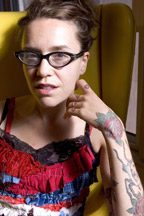Undeniable validation and pleasure come from reading stories featuring lesbian characters or representing a uniquely queer perspective. The following lesbian writers (in no particular order) exert true literary power through their distinctive styles and points of view. They have a way with words, and if they’d like, they can have their way with us.
| Michelle Tea’s autobiography Valencia threw the door wide open for her career. The co-founder of Sister Spit has also published stream-of-consciousness nonfiction, but is surprised by the praise for her fiction. She says, “I feel like Rose of No Man’s Land made a bigger splash because it was fiction, and people get more impressed when you’re making stuff up, rather than heavily doctoring gossip about your own life.” | |
 |
For those who have only seen the screen adaptations of Sarah Waters’ Tipping the Velvet and Fingersmith, get thee to a bookstore. The written form of these historical lesbian tales is far more exciting. And she is garnering attention from a decidedly mainstream audience. Waters remains optimistic about the growing interest in her thoroughly lesbian novels: “There’s always the fear that we’re just getting by on ‘novelty value,’ of course—and you could argue that my books especially, with their period element, are a rather safe choice for heterosexual readers. But I’d like to think that the changes we’re witnessing here will be more lasting than that.” |
 |
Stacey D’Erasmo’s first two novels, Tea and A Seahorse Year, both feature complex gay and lesbian characters that appeal to a wide audience. The former editor of the Village Voice Literary Supplement says, “I’ve been well and widely reviewed, and though there have been some homophobic strains in the response to my work, they haven’t been crushing…I do think I’ve had to work harder sometimes, and be more patient, than I might have had to be if I were either closeted or straight.” |
 |
Dorothy Allison’s graphic portrayals of Southern poverty, family struggles, and physical and sexual abuse—most notably in the National Book Award finalist Bastard Out of Carolina—have made her one of the most recognized out writers in contemporary fiction. |
 |
Jacqueline Woodson makes this list shining a light on the difficult issues that young people face. She attacks seemingly debilitating social issues in her novels, interweaving themes of friendship, family and love. She has received three Lambda Literary Awards and won the Coretta Scott King Award for Miracle’s Boys—which Spike Lee made into a miniseries. Breathing life into the places that mainstream literature ignores, Woodson demonstrates a belief in the transformative power of realistic fiction. |
 |
Jeanette Winterson’s illustrious career started strong with the autobiographical coming-out novel Oranges Aren’t the Only Fruit. The 15 books that have followed are showcases of British wit and experimental form. |
 |
Before Alison Bechdel wrote her critically acclaimed graphic memoir, Fun Home, she’d published 11 collections of her syndicated comic strip. “My Dykes to Watch Out For self is extremely envious of my Fun Home self,” she admits. “I’d gotten resigned to—and kind of bitter about—my failure to get more recognition as a cartoonist, after all these years. When you’ve built up a whole identity around being an outsider, then find yourself in People and Entertainment Weekly, it’s very disorienting. I’m having to adjust my self-concept a lot.” In the works: a 25th anniversary collection of Dykes to Watch Out For and a new memoir. |
 |
Carol Anshaw can leg-press 400 pounds (be still, our beating hearts), but she makes this list for her powerful command of language. About her work, starting with the inventive Aquamarine, Anshaw says, “I hope my lesbian readers will see some of their own stories in my books. I am trying to paint them onto a larger canvas, where their sexuality is only one aspect of who they are. It’s like, OK, we all came out and put up the rainbow flag and did all the hard work of getting here, and now what?” |
 |
Scottish writer Ali Smith has dedicated all seven of her books to her long-term partner. Smith’s playfully experimental work has only recently started to get the recognition it deserves stateside, after The Accidental was shortlisted for the prestigious Booker Prize. |
 |
Psychologist Amy Bloom’s short stories and novels dissolve sexual and cultural taboos with an unparalleled gentle honesty. Start with the National Book Award nominee Come to Me and move on to A Blind Man Can See How Much I Love You, in which several characters from the first story collection return like long-lost friends. |
 |
In addition to writing the classic lesbian coming-of-age novel, Rubyfruit Jungle, Rita Mae Brown is the author of two mystery series, the Mrs. Murphy books, coauthored by Brown’s feline, Sneaky Pie Brown, and the “Sister” Jane foxhunting mysteries. She notes, “[I’m] totally in love with my pack of foxhounds, horses and all the rescue animals. Humans come and go from my life, in the romantic sense, because sooner or later they realize I really do love animals more.” |
 |
Sapphire’s powerful prose took the publishing world by storm, earning her a $500,000 two-book publishing contract. The results, the novel Push and the poetic prose mosaic American Dreams, are fierce and unapologetic examinations of sexual violence, racial disturbances, and lesbian relationships. |
